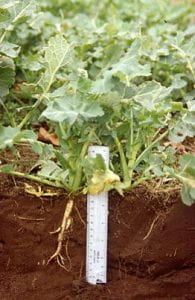
It is well known that soil bulk density and strength are important factors affecting both the shoot and root growth of plants. Areas of compact soil with a high shear strength can be caused by agricultural machinery, and consequently numerous studies have investigated the effects of soil bulk density and strength on plant shoot and root growth.
Previous studies on the effects of strong soil on shoot growth have produced conflicting results. In many studies, both the height and weight of shoots was reduced in strong soils when compared to those grown in weak soils. However, there have been studies where shoot growth was not affected by soil strength and where growth was even promoted in strong soils compared with weak soils.

This study examined the effect of altering soil strength by changing its bulk density on the morphology and mechanics of the major anchorage roots and hence on the anchorage strength of sunflower and maize plants. These results may help to determine the extent to which plants compensate for changes in soil strength and how changes in the cultivation of crops might reduce the losses due to uprooting or lodging.
Results
Soils with a low bulk density had a significantly lower penetration resistance (see photo) of 118±4.4 kPa than the high bulk density soil 325±12.2 kPa (P<0.0001). Soil strength affected the shoot and root systems of both species, but had no significant effect on shoot height.
- In both species roots were thicker closer to the stem base in strong soil compared those in the weaker soil.
- Sunflower tap roots growing in strong soil tapered more rapidly than those in weak soils.
- Only in maize however, were roots growing in weak soil stiffer than those in the strong soil.
Despite only small absolute differences in the penetration resistance of the soil both species growing in strong soil had greater anchorage strength than those grown in weak soil. As a consequence more plants in weak soil lodged compared with those growing in the strong soil.
This study shows that plants can, to a small extent, respond to changes in soil strength, but that changes appear not to compensate fully for alterations in soil conditions. Further that it may be possible by manipulating soil strength to provide a way of controlling lodging.